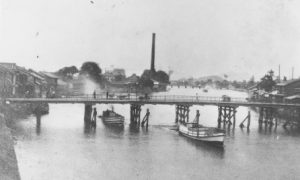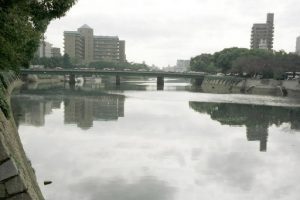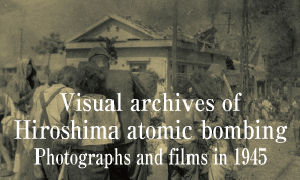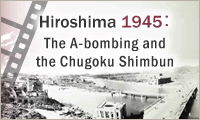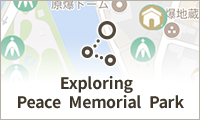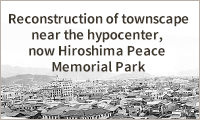Newly discovered photo kept by former resident of hypocenter area in Hiroshima, “City of Water,” vividly captures Shinbashi Bridge, predecessor to Peace Bridge, later washed away by flood after A-bombing
Oct. 16, 1998
By October 15, 1998, a photograph was discovered that captured a panoramic view of Shinbashi Bridge, the predecessor to Peace Bridge, spanning Motoyasu River in Hiroshima City’s Naka Ward. There was no photo showing the entirety of Shinbashi Bridge, whose girders were destroyed in the atomic bombing, even in the archives of the Hiroshima City government. The photo vividly depicts the “City of Water,” stretching over the river delta, before the atomic bombing.
The photo had been preserved by Munemitsu Chikushi, 78, a resident of Yanagawa City in Fukuoka Prefecture. Born to an ophthalmologist family in the former area of Tenjin-machi, which later became one part of what is now known as Peace Memorial Park, Mr. Chikushi took the photo in 1932 when he was a student at First Hiroshima Prefectural Junior High School (present-day Kokutaiji High School). On the back of the photo is written the date “1932・9・30.”
“Motoyasu River was a playground for kids, where they would swim and catch shrimp. I used to take photos of the surrounding area with a German-made camera,” said Mr. Chikushi. During the time he served in the military, four people at his childhood home — his mother, older sister, nephew, and a house keeper — were killed in the atomic bombing. Only a photo album that had been sent for safekeeping to Yanagawa City, his father’s birthplace, remained.
Shinbashi Bridge, which had been rebuilt of wood in 1918, formed part of an important route connecting the Nakajima district (which would later become Peace Memorial Park) and the Ote-machi area on the east side of the river. However, the center bridge girders had collapsed due to the blast from the atomic bombing, with the bridge pier columns later being completely destroyed in a flood. Peace Bridge, designed by the late sculptor Isamu Noguchi, was completed 70 meters downstream of Shinbashi Bridge in 1952.
Michio Ide, 57, is a photographer living in Hiroshima City’s Asakita Ward who has been involved in research on documentary photos related to the atomic bombing in work commissioned by the city’s government. Mr. Ide said, “I have seen many pictures of Shinbashi Bridge depicted in A-bomb drawings made by citizens. However, this was the first photo I have seen that captured the entire bridge. The photo shows riverboats carrying coal and firewood, work on riverbank protection, and the back gates of private homes. This valuable artifact captures the history of Hiroshima, which has existed in concert with rivers.”
(Originally published on October 16, 1998)
The photo had been preserved by Munemitsu Chikushi, 78, a resident of Yanagawa City in Fukuoka Prefecture. Born to an ophthalmologist family in the former area of Tenjin-machi, which later became one part of what is now known as Peace Memorial Park, Mr. Chikushi took the photo in 1932 when he was a student at First Hiroshima Prefectural Junior High School (present-day Kokutaiji High School). On the back of the photo is written the date “1932・9・30.”
“Motoyasu River was a playground for kids, where they would swim and catch shrimp. I used to take photos of the surrounding area with a German-made camera,” said Mr. Chikushi. During the time he served in the military, four people at his childhood home — his mother, older sister, nephew, and a house keeper — were killed in the atomic bombing. Only a photo album that had been sent for safekeeping to Yanagawa City, his father’s birthplace, remained.
Shinbashi Bridge, which had been rebuilt of wood in 1918, formed part of an important route connecting the Nakajima district (which would later become Peace Memorial Park) and the Ote-machi area on the east side of the river. However, the center bridge girders had collapsed due to the blast from the atomic bombing, with the bridge pier columns later being completely destroyed in a flood. Peace Bridge, designed by the late sculptor Isamu Noguchi, was completed 70 meters downstream of Shinbashi Bridge in 1952.
Michio Ide, 57, is a photographer living in Hiroshima City’s Asakita Ward who has been involved in research on documentary photos related to the atomic bombing in work commissioned by the city’s government. Mr. Ide said, “I have seen many pictures of Shinbashi Bridge depicted in A-bomb drawings made by citizens. However, this was the first photo I have seen that captured the entire bridge. The photo shows riverboats carrying coal and firewood, work on riverbank protection, and the back gates of private homes. This valuable artifact captures the history of Hiroshima, which has existed in concert with rivers.”
(Originally published on October 16, 1998)

